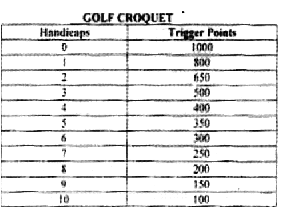Appendix 13
AUTOMATIC HANDICAPPING SYSTEM (AHS)
Croquet NSW is committed to this National handicapping system. The following summary is meant as a guide only to the main features. The complete document is available on the ACA website but from time to time the ACA handicapping committee issues Circulars to extend the application of the system.
The AHS, applicable only to Association Croquet, at that time was adopted by CNSW on January 1, 2005 after an initial trial beginning in August 2004. The following year, (2005), has seen a similar application to Golf Croquet.
Appx 13.1
In both cases there is a distinction between Match Players (MP) and Non- Competition Players.
The regulations for the System can be studied or downloaded from the ACA website. The definitions presented there for these two types of players are as follows:
Match Players are those players who enter singles competitions, at club, interclub, interstate or tournament level. These players are required to keep and maintain appropriate handicap cards. The card should show the current handicap and index and be produced at every event entered.
Non-Competition Players are those club members who do not play outside their own clubs and are not competitively inclined. They are not required to carry handicap cards.
The handicaps of Match Players change as determined by play and the System. This is summarized on the handicap card. A table on that card shows the points gained or lost in play. To be recognized as a Match Player an AHS1 form must be completed after each event.
Non-Competition players, on the other hand, have handicaps which are allocated by the Club Handicapper or a Club Handicap committee.
The Club Handicapper also has a role in assisting the State Handicapper to determine Rapid Improvers.

Appx 13.2
The following tables show the handicap ranges for Association Croquet and for Golf Croquet and the appropriate indices. To illustrate let us suppose an AC player has a handicap of 11 and an index of 1220. He then plays in a competition and first of all loses 40 points which places his index at 1180. This does not amount to a handicap change since the index must fall below 1150 for this to occur. Suppose he then plays very well for the next few games and reaches an index of 1260. Now 1250 is the trigger point for handicap 10, but this does not necessarily mean that his handicap changes. If he has now played the last game in this particular tournament then his handicap changes to 10 with index 1260, but if he still has games to play and we suppose he then loses, so that his index falls below 1250, he ends up with no change to his handicap even though he did pass through a trigger point.
The reader should also consult the ACA Handicap regulations 3.7 and 3.8
This is to be compared with Golf Croquet. The System as applied there is the same except that a player who passes through a trigger point during a tournament does in fact acquire a handicap change immediately.
Appx 13.3
Further points: When a club acquires a New Member, who has little or no knowledge of AC, that member should be assigned a handicap of 24. When the member is able to play as a partner in a Doubles game within the club, then the Club Handicapper should change his handicap to 22. The next step is to handicap 20 which should be assigned when a player demonstrates that he can play a singles game in the club.

Appx 13.4
Now it is very important to note that once the member enters in an inter-club game or a CNSW event, he meets the requirements for being labelled as a Match Player. This has the effect of triggering another feature, which, while not written in the system regulations, has nevertheless been adopted by our Association on the recommendation of the ACA Handicap Committee. This feature requires that once entered into an event such as that described above, he/she must be assigned a handicap no greater than 20 and an index no less than 900. Furthermore, the player’s handicap and index can never revert to 22 or 24, and less than 900 respectively, no matter how badly the member plays thereafter.
Note also that the System applies only to Singles games.
Appx. 13.5
8. Tournament Handicappers shall:
8.1. at the start of the Tournament assist the Tournament Manager in the checking and accurate recording of Player's Handicaps.
8.2. be responsible for all Handicapping issues during a Tournament.
8.3. sign off AHS cards of all Players whose Handicaps have changed at the end of an Event.
Guideline:
* When signing off a card for a handicap change, a Tournament or Club Handicapper should check the calculations leading to the change in handicap, and ensure that recent games have been properly entered on the card.
8.4. watch play of Rapid Improvers during the Tournament.
8.5. in Tournaments or Events have discretion to make handicap reductions at the beginning of or during the Event for any Player who has been identified as a Rapid Improver. Any such reduction (s) shall be effective immediately (see below).
8.6.record, and initial, on a Rapid Improver's card, all handicap changes as they occur.
Guidelines:
* A player who is judged to be a Rapid Improver may have hhandicap reduced before a game at any time (and from time his handicap reduced before a game at any time and from time to time during a tournament but only if the Tournament Handicapper determines that the player’s handicap is too high by at least two steps.
A player who is assessed as only one step ahead of his current handicap will be adjusted by the normal operation of the AHS